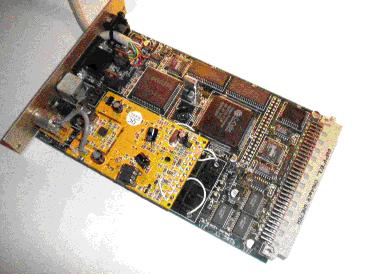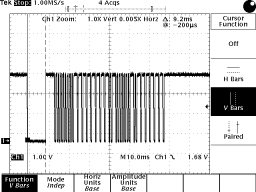

However, the Risc TV podule was made in the late 1990's and considerably predates any idea of terrestrial TV being broadcast digitally. In digital broadcasts instead of using just one carrier to tune to recover the original pictures, the picture is first compressed using MPEG and spread over 8192 carriers - at the receiving end an inverse fourier transform is used to reconstruct the compressed data ready for decoding.
In principle this makes much more efficient use of the radio spectrum so more TV channels can be squashed into the same space occupied by analogue transmissions, but does render the analogue tuner in Risc TV obsolete.
The tuner originally used on the Risc TV podule was a Philips FI1246 which included all the necessary circuitry to take the RF input from an aerial and convert it to composite video and mono audio. As the tuner is a single module in a big tin can all that is required is to find a small enough modern tuner and MPEG decoder to fit the space that has access to composite video and mono audio.

By chance, the new tuner module chosen has a built in menu system driven by a relatively simple infra red remote control pulse. Therefore a tiny 8 bit microcontroller can be used to bridge the IIC bus on the podule to the infra red port, though the pulses can be injected directly into the tuner with wires rather than use infra red light.
Last to be changed is the !RiscTV application. Although on first inspection this would not be possible without access to the original source code, on closer inspection the main run image is just a BASIC program wrapped into an application. Therefore the original BASIC can be extracted and modifications made from there.

Each button press comprises of 4 distinct phases:
Rather than needing to save the actual waveforms and playing them back as the scope does, the 32 bits of data can be encoded in a table in the microcontroller and the original waveform reconstructed on the fly using the above 4 phases. In this instance the PIC 12F1822 from Microchip was selected as it has an IIC peripheral port and internal oscillator along with enough flash memory to hold the tables.
When I start the computer sometimes the Risc TV window is blank. What is wrong?
The !RiscTV application has been unable to find the video timing for the mode that you are in. Normally it is read from the mode definition file for the configured monitor, but when !Configure sets the mode it does not include the frame rate explicitly. To fix this, the initial frame rate must be set in the boot sequence.
To find the frame rate, click on the Display Manager to open the display properties. For example, a 256 colours mode of 1024 x 768 pixels at 70Hz would be
WimpMode X1024 Y768 C256 F70which needs to be put in either Boot:Predesk.Configure.VRAM or Boot:Predesk.Configure.NoVRAM depending on whether video RAM is installed or not.
What host machines does this work on?
Currently only the Risc PC is tested, though in theory the A7000/A7000+ are also supported. More recent ARM processors can optionally be run in 32 bit mode with RISC OS 5 and in preparation for this the podule ROM can be replaced at the same time as the tuner with a 32 bit compatible version. Please note that the disc based !RiscTV application still contains some 26 bit supporting modules which have not yet been rewritten, so the application can only run in legacy 26 bit mode, but since this portion is disc based it can be updated at any time.
Do I need good reception or will a set top aerial do?
You will need a wideband aerial with strong signal, a set top aerial requires a much stronger signal than a roof top fed one. Unlike analogue television the digital services do not degrade gracefully with white snow on the screen - they either decode perfectly or there is zero reception.
Can I get NICAM sound and Teletext after the upgrade?
No, the DVB-T services no longer carry Teletext. Any Teletext addon will be removed during the upgrade process and sent to be recycled. Any sound addon will also be removed as it mechanically clashes with the DVB-T tuner.
After placing an order, the analogue Irlam Risc TV podule should be posted for the upgrade modification, a padded envelope and insured service is recommended for this. The podule will be reworked with a new DVB-T tuner and returned with updated !RiscTV application for desktop control of the extra digital channels:
| Option: | Price: | Comments: | ||
| Risc TV digital upgrade |
| Hardware upgrade to an existing Irlam Risc TV podule Return the unit for the tuner replacement and desktop control software Supplied with supplemental instructions | ||
| Keying upgrade |
| The keying upgrade allows windows in the desktop to partially obscure the TV image without it freezing | ||
| Podule ROM update |
| This replaces the on board ROM with one which is 32 bit compatible, with RiscTVSupport 1.05 |
